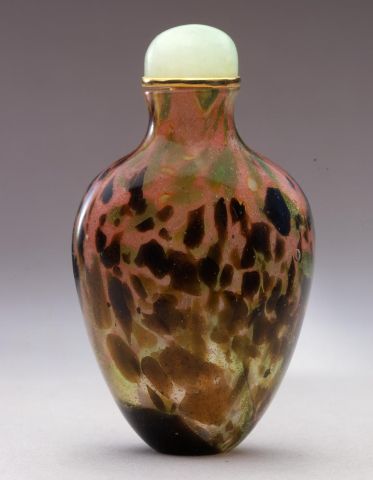
Bottle ID: 00249
CLEAR, BUBBLY W/"SANDWICHED" MULTI-COLORED SPLASHES
Date: 1750-1800
Height: 61 mm
Glass, of flattened ovoid form, with rounded shoulders ascending to a neck with everted lip and tapering towards a slightly concave circular foot, the clear layers of bubbly glass sandwiched with splashes of pink, emerald-green, blue, yellow and brown.
Attributed to Beijing.
Similar Examples:
Crane Collection. no. 683
Hui, Humphrey K. F. and Christopher C. H. Sin. An Imperial Qing Tradition - Chinese Snuff Bottles from the Collection of Humphrey K. F. Hui and Christopher C. H. Sin, 1994, p. 106, no. 128.
Chinese Snuffbottles from the Collection of Joseph Baruch Silver, in Conjunction with the Exhibition at The Israel Museum, Jerusalem, Winter 1987, p. 10, no. 5.
Provenance:
Clare Lawrence Ltd.
Mr. and Mrs. M. DuBoff, Florida
Exhibited:
Annual Convention ICSBS Toronto, October 2007
It is undeniable that the Europeans at Court in the eighteenth century had a significant influence over glass production. The Crane bottle, which finds its parallels in glass from Europe, appears to be a result of this. European influence over glass production in Beijing took a number of different forms. Not only did the Jesuits have a direct influence in the Imperial glasshouse with the Kangxi Emperor appointing Kilian Stumpf to supervise the overall production, but the Palace Archives refer to another Jesuit, Father Gabriel-Leonard de Brossard (Chinese name Ji Wen) about the making of three glass pitchers in 1753 as follows: "Brossard, the Westerner made them...and presented them together with their originals...keep them until the carved decoration is finished, make a few similar fine pitchers next year...." In the following year, 1754, Brossard is referred to again in a memorandum relating to two sets of decorative glass displays as follows: "Brossard, the Westerner made this...send them to Qianqing Palace to be displayed during the New Year festival". In these two entries are a number of fascinating pieces of information. It is clear that Brossard was directly involved in the manufacturing process of glass and that he could produce such fine pieces, including carving, that they would be displayed at the Palace during an important festival. It is also interesting that he was copying originals, which one suspects would be of European origin, although this is not directly specified. However, glass objects from Europe were included in tributes sent by those countries and their influence would have provided the trigger for the production of innovative and unique pieces.
< Back to full list
 English
English 中文
中文